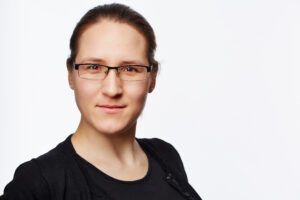Biography
Monika Scholz studied Physics at the Julius-Maximilians-University in Würzburg, receiving her B.Sc. in 2010, and after further studies, she received her Diploma degree in Physics from the Technical University Dresden in 2012. After moving to the US and joining the PhD-Program of the University of Chicago she worked with Aaron Dinner and David Biron.
In 2014 she won a HHMI predoctoral fellowship, which supported her work on feeding behavior in C. elegans. She was awarded a William Rainey Harper Dissertation Fellowship and the Stephen B. H. Kent Prize in Biophysical Sciences for her dissertation. After obtaining her PhD-degree in Biophysics in 2017, she moved to Princeton University as a Dicke-Fellow in the Physics Department. There she used whole-brain calcium imaging of C. elegans to study the neural basis of behavior. She is now at caesar, Bonn to establish a Max Planck Research group with the long-term goal to discover and describe the principles underlying information transfer, processing, and compression in animals.
Education and positions held
- 2019-present:
- Max-Planck Group Leader (W2), research institute caesar, Bonn
- 2017-2019:
- Dicke Fellow, Department of Physics, Princeton University
Research Summary
We use the foraging behavior of the roundworm C. elegans to study how animals temporally coordinate locomotion and feeding behavior. Foraging is of particular interest, as locomotion and feeding are controlled in two entirely distinct neural circuits of the worm. These two sub-networks are only connected by a bilateral pair of gap junctions, forming a bottleneck between the two circuits. Intriguingly, sensory information is transmitted between those two networks: for example, a touch detected by the touch-sensory neurons of the somatic network causes a halt in feeding. How information is transmitted and how it is compressed in this bottleneck is a key question in my group. Bottlenecks are common both in biological networks as well as artificial networks and are often the crucial ingredient for separating relevant information from irrelevant information.
We follow the information flow through the bottleneck experimentally using behavioral assays, neural activity imaging, optogenetics, and genetic perturbations. Ultimately, the goal of the group ‘Neural Information Flow’ is to understand how animals integrate multiple sources of information and how this drives their foraging strategy. We expect that this approach will yield insight on decision making and attention in a small invertebrate brain.
Key publications
- Hallinen, K. M.*, Dempsey, R.*,Scholz, M.*(*equal contribution), Yu, X., Linder, A. L., Randi, F., Sharma, A., Shaevitz, J. and Leifer, A. L. Decoding locomotion from population neural activity in moving C. elegans (submitted) Scholz, M., Dinner, A. R., Levine, E. and Biron, D. (2017). Stochastic feeding dynamics arise from the need for information and energy. PNAS 114,9261–9266
- Lee, K. S., Iwanir, S., Kopito, R. B., Scholz, M., Calarco, J. A., Biron, D. and Levine, E. (2017).Serotonin-dependent kinetics of feeding bursts underlie a graded response to food availability in C. elegans. Nat Com 8, 14221 Scholz, M., Lynch, D. J., Lee, K. S., Levine, E. and Biron, D. (2016). A scalable method for automatically measuring pharyngeal pumping in C. elegans. J Neur Meth 274,172–178.

